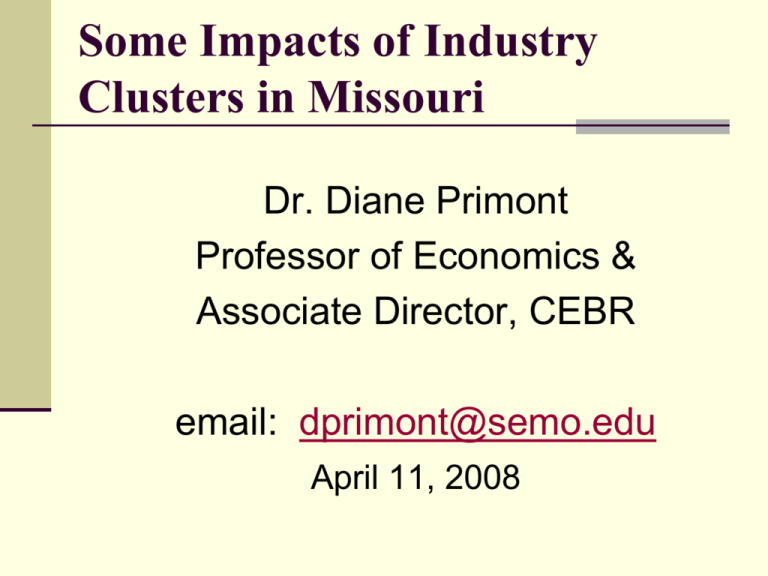Quick Check Microeconomics vs. Macroeconomics
advertisement

Some Impacts of Industry Clusters in Missouri Dr. Diane Primont Professor of Economics & Associate Director, CEBR email: dprimont@semo.edu April 11, 2008 Introduction Economists and Economic Developers often focus on causes of disparities in economic growth rates Why? Even small differences in growth rates can lead to ever larger disparities over time, due to compounding Two Research Questions 1. Are disparities in economic performance among counties increasing or diminishing? “Convergence” 2. How is this performance effected by the presence and extent of industry clusters? “Industry Clusters” Two Research Questions Industry cluster a group of businesses linked by common supply chains, labor needs, technologies, or customers 1. Are Missouri counties converging? Statistical Analysis Conditioning the growth model on: Rurality Industry cluster specialization Graphical evidence Statistical Analysis: Conditioning the growth model Conditional Growth Model Growth in real per capita income 2000-2005 depends on Real per capita income in 2000 (lnpcinc2000) Index of relative rurality (lnirr) Industry cluster specialization (specialization) 1 if county specializes in one or more industry clusters; 0 otherwise Statistical Analysis: Conditioning the growth model grpcinc | Coef. Std. Err. t P>|t| ------------------------------------------------------------lnpcinc2000 | -.2204 .0342 -6.34 0.000 lnirr | -.0437 .0150 -2.91 0.004 specialize | .0208 .0096 2.16 0.033 constant | 2.0510 .3149 6.51 0.000 ------------------------------------------------------------R-squared = 0.3005 Adj R-squared = 0.2816 Graphical evidence of convergence Oregon Reynolds Pulaski St. Louis County Cape Girardeau Shelby Growth by Rurality of County Reynolds Carter Wayne Scotland Monroe Shelby 2. Industry Clusters in Missouri Measuring specialization Location Quotient Specialization in Industries Industry cluster bubble charts State of Missouri Northeast and South Central Missouri Southeast Missouri and the Bootheel Measuring Specialization Location Quotient Ratio of the proportion of a region’s employment in an industry to that of the nation as a whole LQ = (EX/ET)/(NX/NT) EX is region’s employment industry x ET is region’s total employment NX is national employment in industry x NT is total national employment Measuring Specialization LQ = 1: the region’s activity in the industry cluster is similar to the nation as a whole. LQ < 1: the region’s activity in the industry is unspecialized. The greater LQ exceeds 1, the more specialized the region is in the industry cluster. In this study, a region specializes in an industry cluster if LQ >= 1.2 0 Printing & Publishing Mining MANUFACTURING SUPERCLUSTER Transportation & Logistics Information Technology & Telecommunications Glass & Ceramics Forest & Wood Products Energy (Fossil & Renewable) Education & Knowledge Creation Defense & Security Chemicals & Chemical Based Products Business & Financial Services Cluster Biomedical/Biotechnical (Life Sciences) Arts, Entertainment, Recreation & Vistor Apparel & Textiles Agribusiness, Food Processing & Advanced Materials Frequency Measuring Specialization Missouri Counties 2005 Frequency Distribution of Specialized Industry Clusters by industry cluster 30 25 20 15 10 5 Industry Cluster Bubble Chart Hypothetical Data LQ in 2005 Mature 2 Stars 1 -10 Transforming 10 0 % Chg. in LQ 2001-2005 Emerging Industry Cluster Bubble Chart Missouri's South Central Region Industry Clusters LQ2005 Forest & Wood Products 2.5 Biomedical/ Biotechnical 2 1.5 Education & Knowledge Creation Energy 1 -50 0.5 0 50 0 % chg. in LQ 2001-2005 100 Industry Cluster Bubble Chart Missouri's Northeast Region Industry Clusters LQ in 2005 1.6 Mining -60 -40 Manufacturing Supercluster 1.2 -20 0 0.8 20 60 Chemicals 0.4 0 40 Forest & Wood Percentage change in LQ 2001-2005 Glass & Ceramics Industry Cluster Bubble Chart Mis s ouri's S outheas t R eg ion Indus try C lus ters L Q in 2005 Biomedical/ Biotechnical -60 -40 Energy 1.6 Forest & Wood Product s -20 Transportation and Logistics 1.2 0.8 0 20 0.4 0 P ercentage C hange in L Q 2001-2005 40 Defense & Security Business & Financial 60 Industry Cluster Bubble Chart Missouri Bootheel Region Industry Clusters 2.5 Agribusiness LQ in 2005 2 Biomedical/Biotechnical -100 Transportation and Logistics 1.5 -50 0 50 1 0.5 0 Percentage change in LQ 2001-2005 Manufacturing Supercluster 100 Conclusions Achieving high economic growth is a challenge for any county or region, but particularly for rural counties Regions with a greater number of “star” and “emerging” industry clusters tend to grow faster May be useful to target these industries for further development






